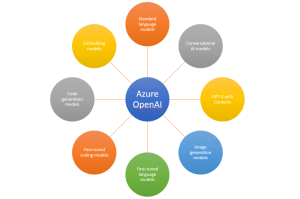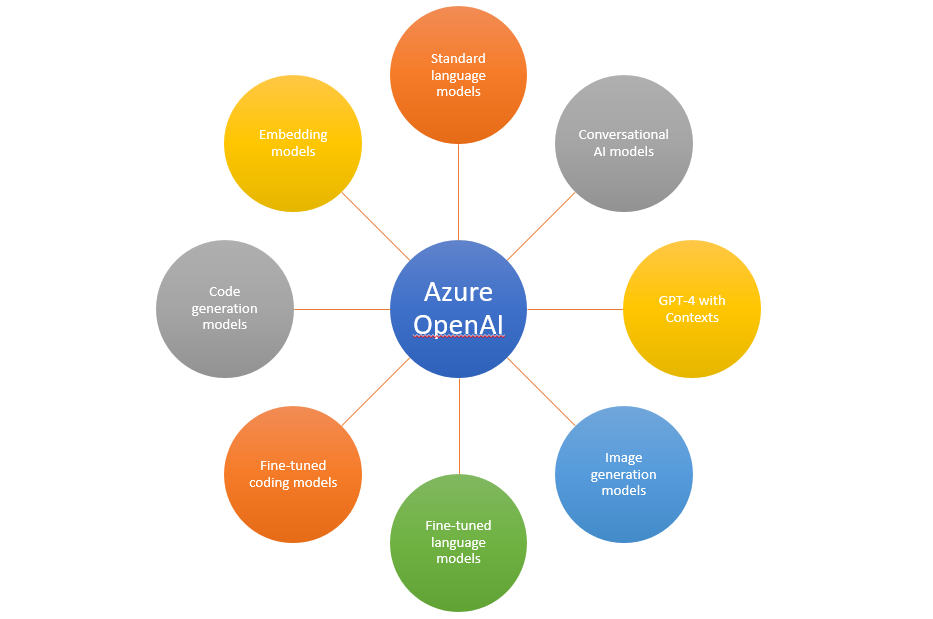
Azure OpenAI, an offering from Microsoft Azure, empowers developers, researchers, and enterprises with the transformative capabilities of Artificial Intelligence (AI). In this blog post, we explore Azure OpenAI’s service details and pricing information, providing you with insights to harness the immense power of AI.
Azure OpenAI Services Information
Azure OpenAI service provides a range of large language models from standard machine learning models to fine-tuned ones for specific tasks. We can build intelligent chatbots, automate code generation, or enhance natural language understanding. We can leverage conversational AI models for interactive virtual assistants that elevate user experiences and streamline operations. Image generation models can be used to produce stunning, realistic visuals. Let’s get into further details of this Azure OpenAI services and pricing information.
The following is the detail of different Azure OpenAI services along with examples:

- Standard language model: A standard language model refers to a pre-trained model that can understand and generate human-like text in natural language. It has been trained on a large corpus of text and can be fine-tuned for specific tasks or used as-is for various language-related applications. One real-world use case for a standard language model is in chatbot development. By utilizing a standard language model, developers can create chatbots that can understand and respond to user queries in a conversational and natural manner.
- Conversational AI model: A conversational AI model is designed to simulate human-like conversation and interaction. It combines language understanding and generation capabilities to engage in back-and-forth conversations with users, providing meaningful responses. An example use case for a conversational AI model is in customer support. Companies can deploy conversational AI models as virtual assistants to interact with customers, answer frequently asked questions, and provide support, thereby enhancing customer service experiences.
- GPT-4 with 8K / 32K context: GPT-4 with 8K or 32K context refers to the fourth iteration of the Generative Pre-trained Transformer (GPT) model, capable of processing and understanding text with either an 8,000-token or 32,000-token context window, respectively. The context window represents the amount of text the model considers for generating responses or completing tasks. GPT-4 with a larger context window can be utilized in more extensive text-based applications, such as long-form content generation, summarization, or document analysis. For instance, it could be used in automated content creation systems where generating lengthy articles or reports is required.
- Image generation model: An image generation model is a deep learning model that can generate new, realistic images based on the patterns and features it has learned from a training dataset. These models use techniques such as generative adversarial networks (GANs) or variational autoencoders (VAEs) to create visually coherent and novel images. One practical application of image generation models is in the field of creative design. Artists and designers can use these models to generate unique and inspiring visual concepts, which can serve as a starting point for artwork, graphic design, or product design.
- Fine-tuned language model: A fine-tuned language model is a pre-trained language model that has been further trained on specific domain-specific or task-specific data. Fine-tuning allows the model to adapt and specialize for particular language understanding or generation tasks. In the medical field, a fine-tuned language model can be used for medical text analysis. By training the model on medical literature and patient records, it can assist healthcare professionals in tasks such as clinical document summarization, medical coding, or natural language understanding in electronic health records.
- Fine-tuned coding model: A fine-tuned coding model is a language model that has undergone additional training on a codebase to understand and generate programming code. This training enables the model to provide coding suggestions, assist in code completion, or automatically generate code snippets. One practical use case for a fine-tuned coding model is in software development. Developers can utilize the model to improve their coding efficiency by leveraging intelligent code completion and suggestions, which can help reduce errors, increase productivity, and provide assistance in writing complex code structures.
- Code generation model: A code generation model refers to a model designed specifically for automatically generating code based on given specifications or requirements. These models are trained on large code repositories and can assist in automating repetitive or boilerplate code writing tasks. An example use case for a code generation model is in web development. Developers can use the model to generate HTML, CSS, or JavaScript code snippets based on design mockups or high-level descriptions, speeding up the process of building web applications and reducing manual coding efforts.
- Embedding model: An embedding model is a type of language model that transforms words, sentences, or documents into dense vector representations, where similar items are represented by vectors that are close together in a high-dimensional space. These embeddings capture semantic relationships between words or texts. An application for embedding models is in natural language processing (NLP) tasks, such as sentiment analysis or document clustering. By converting text into meaningful numerical representations, embedding models enable algorithms to analyze and compare texts based on their underlying meanings or similarities, aiding in tasks like document classification or recommendation systems.
Azure OpenAI Services Pricing Details
The following is the pricing details for different services across three regions such as East US, South Central US and West Europe (As of 27th May, 2023).
| Category | Model | Description | Pricing / 1,000 tokens | Pricing / 100 images | Pricing (Training / compute hour) | Pricing (Hosting / hour) |
|---|---|---|---|---|---|---|
| Language models | Text-Ada | Standard language model | $0.0004 | – | – | – |
| Text-Babbage | Standard language model | $0.0005 | – | – | – | |
| Text-Curie | Standard language model | $0.002 | – | – | – | |
| Text-Davinci | Standard language model | $0.02 | – | – | – | |
| Code-Cushman | Code generation model | $0.024 | – | – | – | |
| Code-Davinci | Code generation model | $0.10 | – | – | – | |
| ChatGPT (gpt-3.5-turbo) | Conversational AI model | $0.002 | – | – | – | |
| GPT-4 | 8K context | GPT-4 with 8K context | $0.03 | – | – | – |
| 32K context | GPT-4 with 32K context | $0.06 | – | – | – | |
| Image models | Dall-E | Image generation model | – | $2 | – | – |
| Fine-tuned models | Text-Ada | Fine-tuned language model | $0.0004 | – | – | – |
| Text-Babbage | Fine-tuned language model | $0.0005 | – | – | – | |
| Text-Curie | Fine-tuned language model | $0.002 | – | – | – | |
| Text-Davinci | Fine-tuned language model | $0.02 | – | – | – | |
| Code-Cushman | Fine-tuned code model | $0.024 | – | – | – | |
| Models | Text-Ada | Standard language model | – | – | $20 | $0.05 |
| Text-Babbage | Standard language model | – | – | $22 | $0.08 | |
| Text-Curie | Standard language model | – | – | $24 | $0.24 | |
| Text-Davinci | Standard language model | – | – | $84 | $3 | |
| Code-Cushman | Code generation model | – | – | $26 | $0.54 | |
| Embedding models | Ada | Embedding model | $0.0004 | – | – | – |
| Babbage | Embedding model | $0.005 | – | – | – | |
| Curie | Embedding model | $0.02 | – | – | – |
Conclusion
We looked at the high level summary of different services provided by Azure OpenAI services. In addition, the prices of each of these services were explored. Note that this page will be updated from time-to-time for up-to-date information. Please feel free to reach out for any clarification you may have including use cases where these Azure OpenAI services can be used and how to go about using these services. Also, reach out to get clarifications on the pricing details for different Azure OpenAI services listed in this blog.
- Mathematics Topics for Machine Learning Beginners - July 6, 2025
- Questions to Ask When Thinking Like a Product Leader - July 3, 2025
- Three Approaches to Creating AI Agents: Code Examples - June 27, 2025
I found it very helpful. However the differences are not too understandable for me